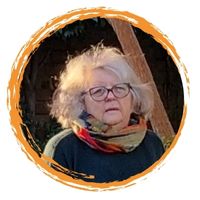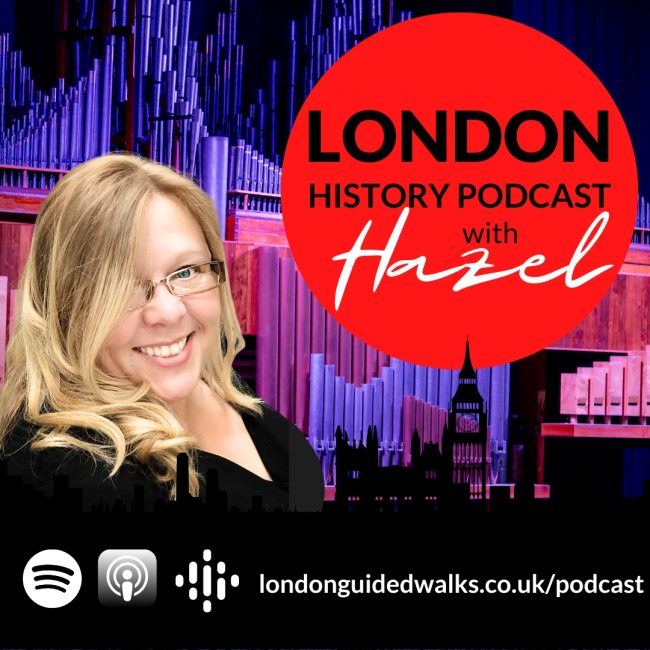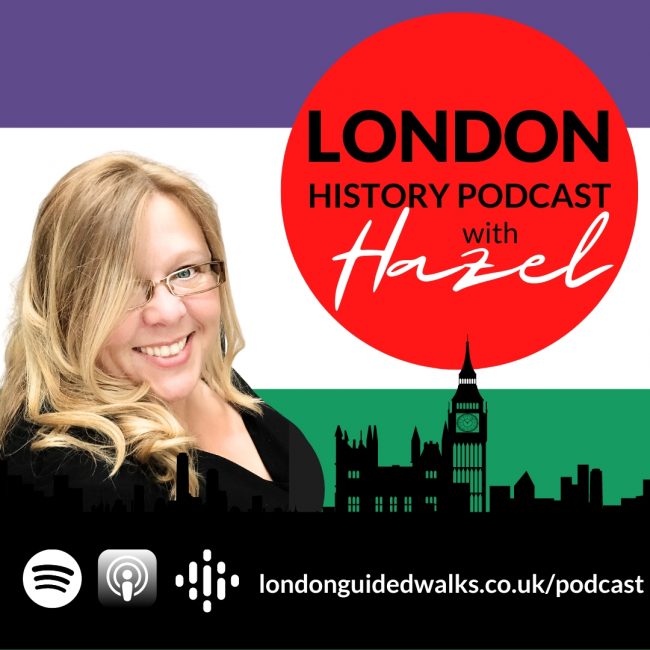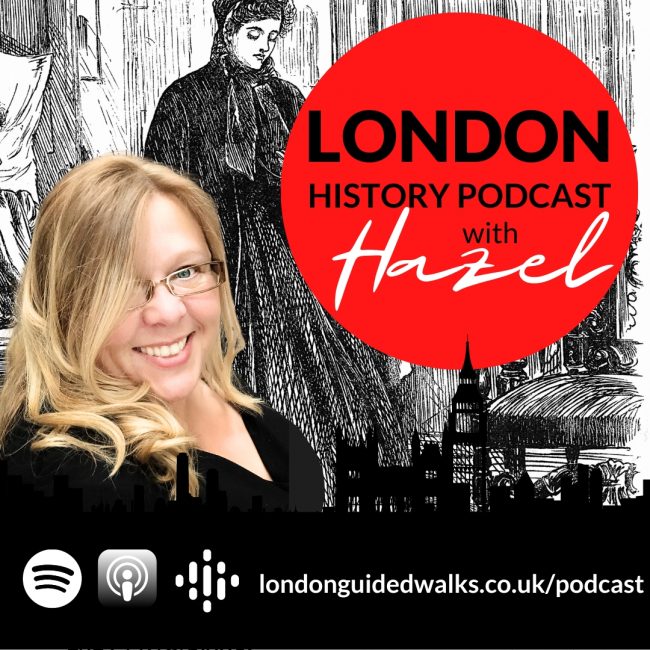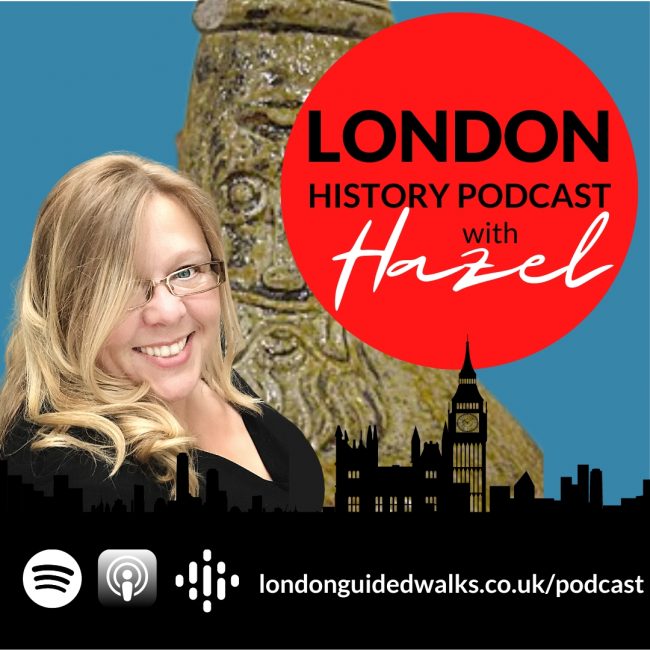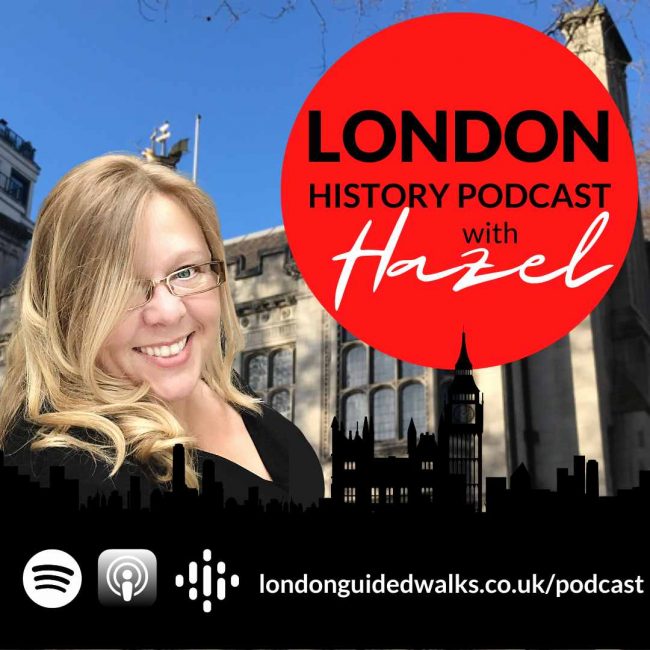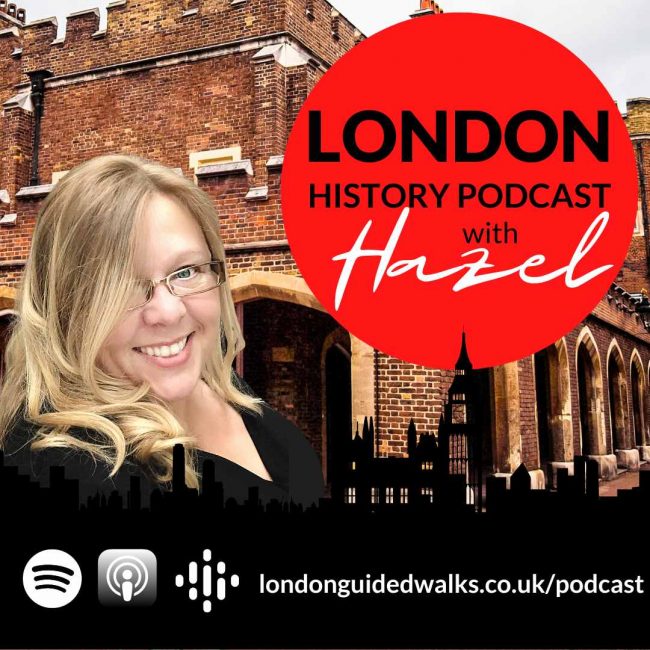Join Hazel Baker as she talks with Lesley Russell about the DeLaune family who has researched connections to several Huguenot families who came to England as refugees from religious persecution in 1572 and who made their home in the ruins of the former Blackfriars Priory. Learn more about the families and the area the in which they lived and their community.
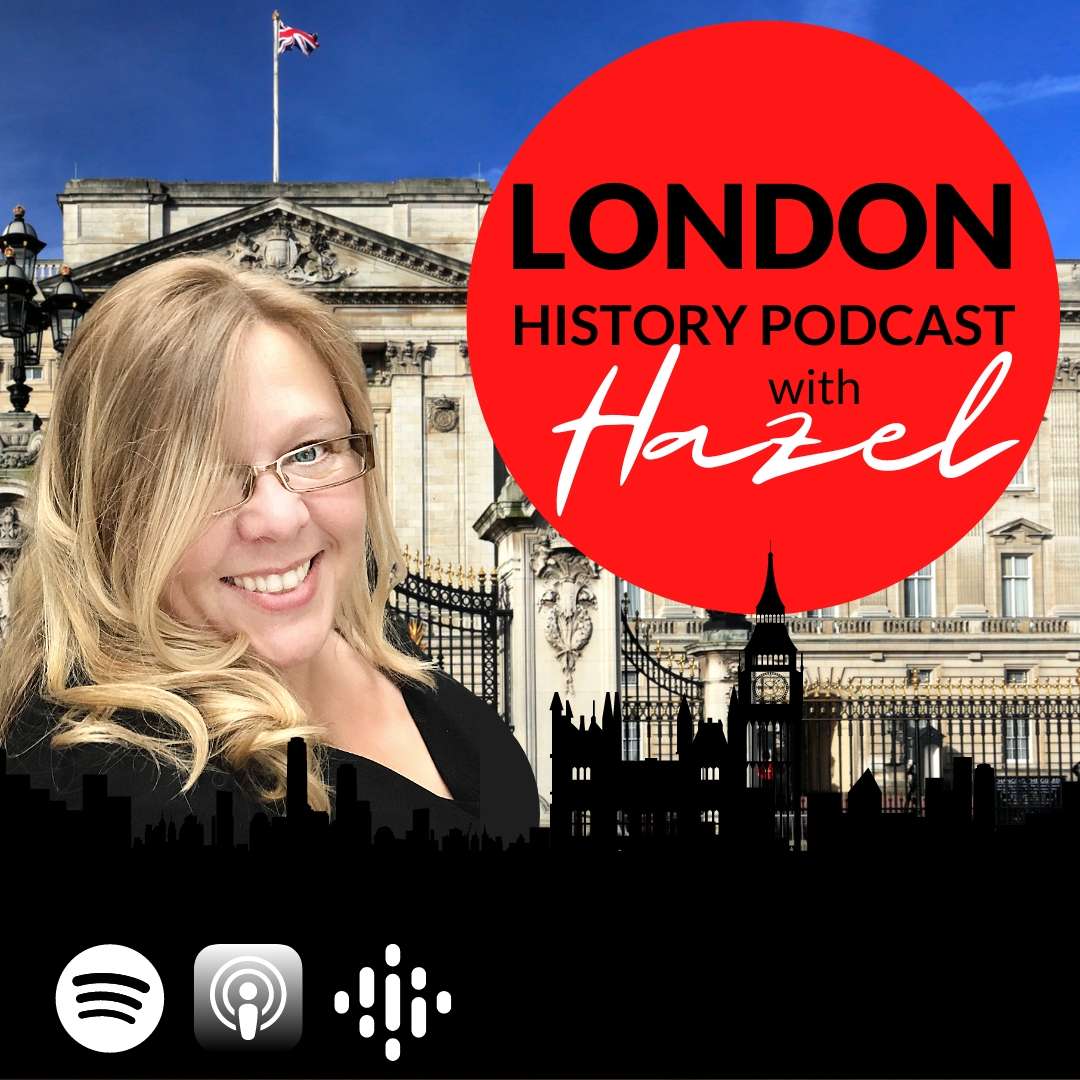
DeLaunes of Blackfriars
Recommended Reading:
The DeLaunes of Blackfriars Gideon DeLaune and his Family Circle revisited by Lesley Russell
Other Tudor Podcast Episodes:
44. Tudor London and John Stow
76. Elizabeth & Mary: Tudor Cousins
Hazel is an active Londoner, a keen theatre-goer and qualified CIGA London tour guide.
She has won awards for tour guiding and is proud to be involved with some great organisations. She is a freeman of the Worshipful Company of Marketors and am an honorary member of The Leaders Council.
She has been an expert guest on Channel 5’s Walking Wartime Britain (Episode 3) and Yesterday Channel’s The Architecture the Railways Built (Series 3, Episode 7).
Lesley Russell is a retired teacher, living in Australia. When playing around on a well-known genealogy site turned up connections to several Huguenot families who came to England as refugees from religious persecution in the 1572. She began began some serious digging into the vaults of internet search engines and anything else she could lay my hands on to discover more about them and the times in which they lived.
The result? Two updated studies of two notable medical and clergy families – the DeLaunes and the Chamberlens, related by marriage. Both of these families came to England as refugees, found royal favour and established a dynasty.
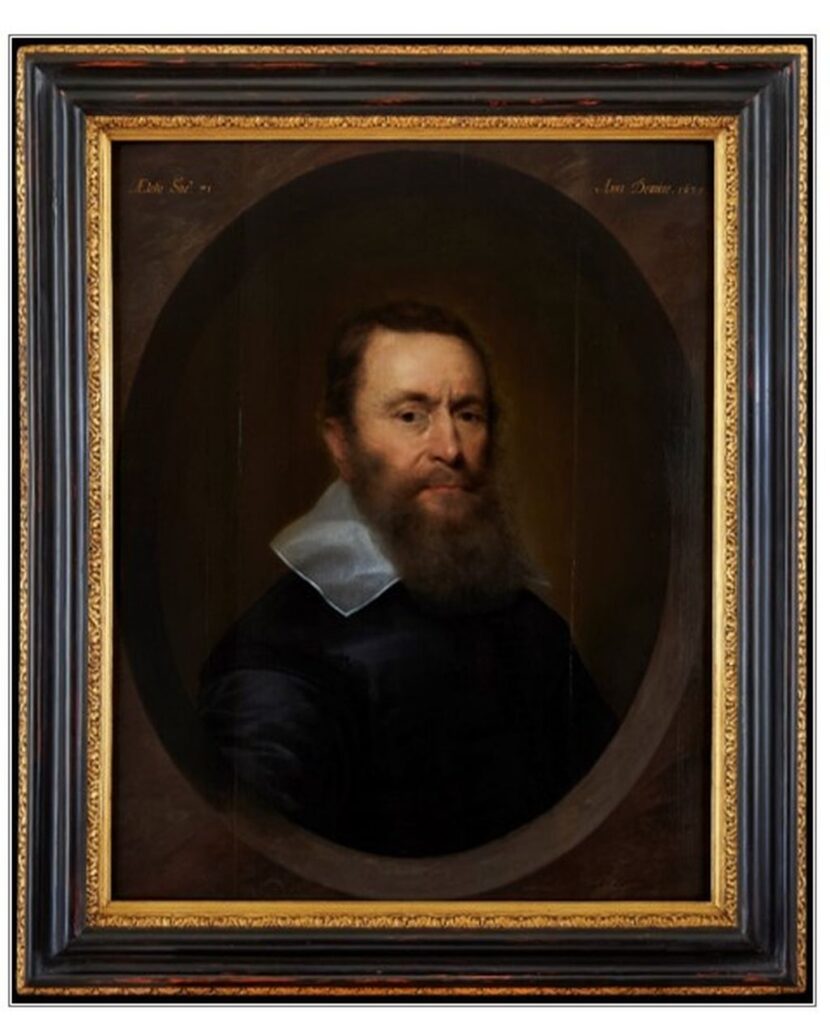
Credit: By kind permission of the Worshipful Society of Apothecaries of London.
Show notes:
Hazel Baker: Hello and welcome to our London history podcast, where we share our love of London, its people, places and history. This podcast is designed for you to learn things about London that most Londoners don’t even know, all in 20 minutes. I am your host Hazel Baker, qualified London tour guide and CEO of www.londonguidedwalks.co.uk
Our walking tours are for those who love London and want to make the most of their time here, no matter whether it’s for a weekend or a lifetime. We aim to deliver insightful and well-prepared London guided walks with genuine enthusiasm and professionalism. And in this podcast, we try to do exactly the same.
Get that cup of tea, put your feet up and enjoy!
Joining me today is Leslie Russell, a retired teacher living in Australia when playing around on a well-known genealogy site, she turned up some connections to several Huguenot families who came to England as refugees from religious persecution in 1572, she began some serious digging into the volts of internet search engines and anything else you can lay our hands on to discover more about them and the times in which they. The result? Two updated studies of two notable medical and clergy families, the DeLaunes and the Chamberlains, related by marriage.
Both of these families came to England as refugees, found Royal favour and established a dynasty. The main name we know about now is Gideon DeLaune.
Lesley, would you like to introduce us to the DeLaune family.
077 The DeLaunes of Blackfriars
Hazel Baker: Hello, and welcome to our London history podcast, where we share our love of London, its people, places, and history. This podcast is designed for you to learn things about London that most Londoners don’t even know. In 20 minutes.
I am your host Hazel Baker, a qualified London tour guide and CEO of London Guided Walks
Don’t forget if you enjoy what we do then please rate and review. It warms the cockles of my heart to read your appreciation of this labor of love.
Get that cup of tea. Put your feet up and enjoy.
Joining me today is Leslie Russell, a retired teacher living in Australia when playing around on a well-known genealogy site, she turned up some connections to several Huguenot families who came to England as refugees from religious persecution in 1572, she began some serious digging into the volts of internet search engines and anything else you can lay our hands on to discover more about them and the times in which they. The result? Two updated studies of two notable medical and clergy families, the DeLaunes and the Chamberlains, related by marriage.
Both of these families came to England as refugees, found Royal favour and established a dynasty. The main name we know about now is Gideon DeLaune. Leslie, would you like to introduce us to the DeLaune family?
Lesley Russell: It starts with the father William DeLaune. He was born in about 1530, went to Paris and Montpellier to study as a physician under Duret and Rondelet, France’s leading professors of Physic at that time. At some point in that time became a member of the French reformed church, which is the Protestant church in France. They’re very, Calvinistic very, very tough people. I think very hardline, quite fundamental Christians in many ways.
He also studied for the ministry and he became a minister and he was living in Générac and he married the daughter. His father-in-law was probably the minister. The French reformed church is in a little town called Uzès, which is a beautiful little town near the point of Languedoc . And it’s one of my favourite places in France and they, and they married there and proceeded to have a family.
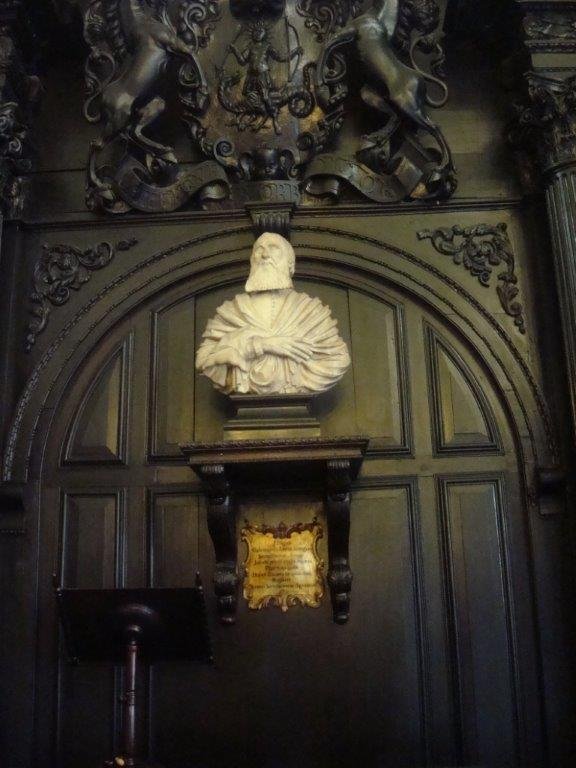
Credit: Lesley Russell
His father-in-law died in about 1570. And he returned to Normandy. At that point, he asked to be released from his ministry in the south and to go north because he had the support of his own children, his wife, sister, as well, and clergyman didn’t make a lot of money. The 24th of August 1572, Bartholomew’s Day, massacre of French Huguenots (Protestants) occurred in Paris. There were thousands of Huguenots all over France. This set off a great flood of refugees to come to England. Now they came to the south of England from France. They mostly came to the south of England at the same time. The Protestants in the low countries, which were under the control of Spain were having their problems too.They were coming to England and coming to the east coast of England to Norwich and Suffolk and places like that. They landed in Rye, of course being a port in those days and it was on the coast. There were so many refugees that arrived in Rye at that point, something like 1,500 people, which is in different times, they actually appealed to bills of the first for financial help for support.
You’ve got to really sort of think of how little these places must have been and have these floods of people coming through. They stayed in Rye for a while and another child was born there and then they made their way to London and they moved into Blackfriars. At this point, there were four boys.There was probably a child who came with them, a son who died in 1589.
[00:04:19] Hazel Baker: And how do we know about that?
[00:04:20] Lesley Russell: All the foreigners had to be, there was a census taken off and the Return of Strangers, it was called, which remarks that William DeLaune had one male and three male children that extra taxes had to be paid for if you were farming. So we know there was a third son.
William DeLaune became a physician in London. He served at the church at the fridge reform church in Threadneedle Street.
[00:04:43] Hazel Baker: Did you want to expand on the Liberty at Blackfriars?
[00:04:48] Lesley Russell: The Liberty there, were not subject to the rules and regulations of the city of London. It was an independent sort of enclave within the city. And it had a very, very mixed population of aristocracy, foreigners, artisans, all sorts of people were living in this area and. The freedom that they had in the lip, the Liberty was inherited from the fryer and it would be free from city taxes, arrest by city officials.
They were free to practice crafts without belonging to a Guild. And they attracted a lot of foreign artisans because of that, because you, if you were foreign, you couldn’t join the city guilds. It was a Puritan strong. So the church was a very pure origin church. It was within the church of England, but still that Puritan ethic within the church, there was a sizeable fridge community in there as well.
And he became part of that. When the monastery was sold to the master of the king dribbles, the building was all converted into apartments and you can imagine it must’ve been quite chaotic in lots of ways. I think the tendency that each took was seven rooms in the great hall of the monastery, which is the great freighter.
Now there’s something interesting about this. This is the room where Catherine of Aragon sat and refused to defend her. Against the papal Legates Cardinal Woolsey. So this is right in the middle of the history of England to start with. And it was a big area with seven rooms. So he was doing okay. He really was. There were five more children born. He raised his medical practice. He was forbidden to be a minister and a physician; in those times it was not allowed. So he appealed to the college of physicians and pleaded his case. And he was granted permission to be both minister and physician. And he then had his medical qualifications or his degree incorporated at Cambridge. So he was doing okay in that way.
In 1583. He published a major theological work, which must’ve taken him years and years and years to do, which was a treatiesI thought on Calvin’s Institutes of the Christian Religion. And that was published many times into different languages, and was a major work of study for Calvin’s.
He became a very influential member of the society. He was living in the Blackfriars circle, which included people; his neighbour, Lady Elizabeth Russell was the sister-in-law of Lord Burley and sister-in-law Nicholas Bacon was another brother-in-law of hers. We’re talking people right at the top of, of not only social banding, but of academic and intellectual standing in the city.
In 1593, he bought a large building, a large tenement within the Blackfriars thing, the original apartments, those, the great Fraser, those rooms in the great freighter were sold to James Burbage, the theatrical entrepreneur, and he wanted to start a theatre there. Europeans did not want that theatre to happen at all. And so he fought. Very bitterly against it. And they won and James Burbage life, he lost a lot of money. He actually died the following year. It was a very bitter and difficult time. I think his son actually managed to open the theatre in 1608, but this is why we see the Playhouse Yard in the Blackfriars area. And the rooms had been used earlier by an Italian fencing master.
[00:08:27] Hazel Baker: sounds like a very exciting place to live. Lots of people from different ways of life, trying to make their way in the city of London with certain constraints and them having to find a way round it in order to succeed.
[00:08:43] Lesley Russell: Very dynamic. Very exciting. All sorts of people. That’s right. I mean, Petrolia who was the best publisher in England at the time, another Frenchman living there, there were all sorts of interesting people living there and they were in their own environment. They weren’t under the control of other people. It must’ve been quite an extraordinary place to be really.
William Delaune died in 1610 and by the time he died, he was a very respected member of the society. His wife had died a couple of years before him and he had asked to be buried in the churchyard as near to his dear wife as he could. And it’s a lovely thing of a family man.
He left quite a lot of property to his children. He was able to lend him something like £350 to somebody and which was a lot of money in those days.
[00:09:42] Hazel Baker: How was he making his money then? Cause this is a huge amount of money.
Lesley Russell: Through his medical work and through the supply of drugs and, and, and medications and things, because that was quite a lucrative thing. And that leads on to Gideon Gideon. His eldest son became an apothecary and it’s very likely that he studied under. And his father was with his father. When his father died, there were accounts for as much as £200 owed to him for medical supplies and things.
So it gives you an idea of sort of some of the ss of money that might be in delved. , here, here he has, he’s got this large family of boys. And what do you do with them when you have to get them educated? Gideon became an apothecary and prompt. Possibly at that point because there may, , he was still making his way.
And so he had to start working. The other boys all went to universities in England and in Europe, Isaiah became a physician and studied at Leiden in Laden which was the university that Protestants went to. He studied medicine in Leiden. Peter went to Cambridge, which was the Protestant university. He studied theology and he also went to Leiden and he became the minister of the Dutch Reformed church in Norway. Nathaniel went to Geneva and Lee and Leiden and studied there and became a minister, then went and worked in Dieppe. His university expenses were paid for by the parish in Dieppe on the requirement, but he would go back and work for them.
Paul became a physician and he studied at Cambridge and then went to Padua, a great medical university and he studied there. He also spent several years in Ireland in the service of the law deputy, he was a professor of physics at Gresham College and he was an Army Doctor in a really interesting career.
The girls married. Sarah married Peter Chamberlain, the male midwife, who with his brother, were the inventors of modern forceps. They have a place in the middle in medical history and there were two other daughters, Esther and Elizabeth. Esther married a clergyman, and Elizabeth married a Goldsmith and they all lived in London and most of them lived in Blackfriars.
They must’ve been quite lively, he makes reference to it being quite a nursery at one stage, or William makes a reference to the nursery with all these children and grandchildren and everything all around. Gideon stayed in Blackfriars. He didn’t go off to university anywhere else. He married Judith Chamberlain.
The chamberlains, there were lots of Chamberlain’s quite common seems to be quite a common name, but Abraham Chamberlain was a merchant and Thomas Chamberlain was a merchant as well. And she was connected to that family. They had 13 children and only to survive to adulthood, which it just doesn’t bear thinking about.
In 1592, he sort of really first appeared named as an apothecary on a lease signed for a. Fry’s property that included the use of a shared privy and the obligation to pay towards church and minister maintenance. So, , you, you, you were, you weren’t allowed to get away with just being there. You had to do all the right things.
[00:13:08] Lesley Russell: 1606. He was appointed a Royal apothecary to queen Anne, wife of James I. There were a lot of French appointments to the court. At that point, he was paid £20 a year for it. Which doesn’t seem a great deal of money, but medications and drugs, protein, hundreds of pounds. And when you think that things like Carl dissolved in pomegranate juice was a medication that was recommended dissolved pearls, unicorn horn was considered a universal cure and as protection from poisons and a preserver of youth.
So it was still very much the age of all the weird and the wonderful. But the world was changing the exploration of new countries. And what have you, new things were coming in new plants, new medications, new ideas.
He made a great deal of money. We didn’t get into the war. With the invention or the concoction of a stomach pill, a great purger. And the king liked it very much and it made his fortune for him. And he did become a very, very rich man. And it was still being sold a long time after this he became a Freeman of the City in 1623. That was after a special act of petition to the king, his civic duties added to those that he had with the Apothecaries.
He was appointed to the court of common council, which was the city’s legislative board. But he’s foreign birth prevented him from becoming an alderman and he was elected in 16, 25 as an alderman, but had to stand out because he was foreign. He bought large properties in Kent and in infant share and he bought more property in black for us all the time.
He’s really prospering. He’s doing very well for himself. And in 1635, he applied for denunciation, which was the act of by special decree from parliament of becoming a citizen. So he had to do that in order to be able to leave his. To any foreigner couldn’t leave property to people. That’s just a brief thing about Gideon’s personal life, really, and what was going on, but he’s mostly remembered for his efforts with the worshipful society of Apothecaries and he is considered to be their founding benefactor and medicine was becoming more scientific. We’re getting away from the old herbal things. And what have you. We were actually the beginning of creating the idea of, of drugs that really work and we want to know why they work and we want to control the quality of them because you don’t want just anybody calling themselves an apothecary and going on and, and causing harm.
By 1610 the Apothecaries were ready to separate. They wanted their own Guild. They appeared before the grocers to state their case and Gideon, who was the leader of the campaign was dismissed because he was foreign. So out you go, we’re not going to listen to you. Foreigners were not admitted to London guilds at that time so they petitioned the king and his response was much more positive and prompt. He was very interested in medical affairs and his own life and growth, the Grocers protested, but they failed to win their case. And it took three, three years led by three years of negotiating and backwards and forwards and things, the charter was granted to them on the 6th of December 1617.
Only Freeman of London could be a member of the Grocers, but the Apothecaries didn’t have that strict stipulation. They allowed foreigners. There were five foreigners admitted as members to the new society. And Gideon DeLaune, of course, was one of them. And so he was very, very influential in that the charter allowed for pharmaceutical practice to become a profession rather than the.
The Apothecaries shared control of the profession with the physicians, but they under the supervision of the physicians and it produced a an improved Pharmacopeia members could make buy, sell drugs, and they could train apprentices and supervise the quality of drugs, prosecuting, punished, fraud, and advance the science of therapeutic medicine. They’re aiming high. They’re really wanting to lift the game completely and become regarded as a professional body rather than a trade.
[00:17:39] Hazel Baker: It’s a whole new world for them. Isn’t it? It’s something that they are also helping to create.
[00:17:43] Lesley Russell: It is a whole new world. That’s right. And they were successful. And to this day they examine and, and, , they, they, they hold their standards very, very high in. But Gideon as well as being instrumental in getting to the king and, and, and getting the, the charter agreed to and things he assisted greatly in the purchase of the Blackfriars property, which carbon problem house it was called.
It was, had been the Priory, his guest house, and it was next to his own private. And in 1632, he loaned them quite a deal of money to buy that property. His drive and determination was crucial to the founding of the society and in a minute and Memorial in 1648. It says, says it is hereby declared and so thought fit by the court.
[00:18:35] Lesley Russell: That the same Mr. DeLaune was a principle means for the procuring of the seed company to be made into a corporation and for the purchasing of the capital Miserables, which now belonged to the said company called Apothecaries hall. So by this time, Gideon was hidden there. Eighties. He was born in 1565.
And so here we are now in 1648 and he gets this formal recognition. Then his Royal appointment ended with the death of the queen and with the arrival of Charles the first and there were no more Royal appointments. Royal appointments of course were Protestants and, and James I was much more leaning to that Scottish Calvanist thing as well.
So with Charles and with Henrietta Maria, life at court obviously changed a lot. And the influence of the, of the reformed churches in that group moved, moved away. Charles sort of verse two to calling for forced loans to be made to the crowd. And Gideon had to pay the. Reluctantly, he remained a royalist which many huguenots didn’t. He died in 1658 at his daughter’s home in Highgate.
His only son had died, the surviving son from all those children, had died in 1636. So in 1658 Gideon, being 94, something like that, when he died, was buried in the churchyard at St Anne’s, in Blackfriars with all the pomp and circumstance of an oven, ornament of the city of London, which was a huge procession. And he left this great fortune.
[00:20:17] Hazel Baker: So what about the remaining family then? What happened to this fortune?
[00:20:22] Lesley Russell: There were, there were children and there was, they were the next generations. Okay. There was William, his three sons, one of them died in a house fire in London where everybody was killed near St Paul’s. And another one died when a wall, a brick wall fell on him. And the third one married late, never had children. So Williams Gideon’s fortune passed through to the grandson and ended up at one of the girls but her daughters were spinsters. And so finally it passed to a distant cousin and the whole thing came to an end, which is sort of quite a sad way to think of it, in many ways.
His legacy is Apothecaries Hall in Blackfriars. The Great Fire of London destroyed virtually all of Gideon’s world. His house was gone, everything was gone. The church where he worshiped was gone. Where he was buried, there was a great vault in the entry of the church where the family went with the big stone over the top of it, declaring that this was the DeLaune family vault.
[00:21:38] Lesley Russell: Disappeared. All gone. The church wasn’t rebuilt. The parish was amalgamated with St. Andrew-by-the-wardrobe; the land that it occupied was added to the burial ground that is now that little island yard. By the time the fire went through there, the DeLaunes had left Blackfriars. They were living in Kent.
William had died and his widow, before the Great fire had sold the DeLaune property in Blackfriars to the Apothecaries so they were able to increase their space there. T Apothecaries hall is the oldest hall. It was the first to be rebuilt. There’s an interesting point that the French church was the first church to be rebuilt after it was completed by 1669, the French reformed church had built the church again.
[00:22:35] Hazel Baker: Have you got a favourite story about any of the Delaune’s?
[00:22:39] Lesley Russell: Paul’s story, the brother Paul’s story. He’s the one who went off to Pedro and finished up at the age of 70 as the first Physician General of the British Navy on the first designated Naval hospital ship and disappeared and nobody knows what happened.
There’s just so many fabulous stories in there, , but then there’s all the extra odd people around to the side due to the odd pirate and it’s brilliant.
[00:23:10] Hazel Baker: Well, thank you very much for sharing this. The story of the DeLaunes and the Worshipful Company of Apothecaries.
To our listeners, if you want to know more about the area of Blackfriars, then we do do a best of Blackfriars walk and also a private tour.
That’s all for now. See you next time.


